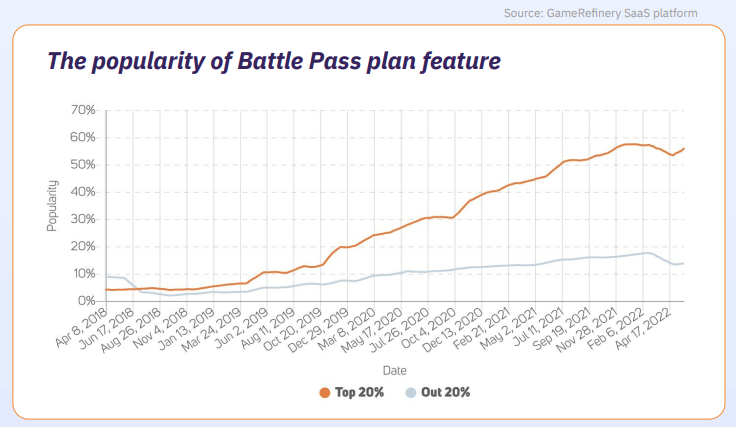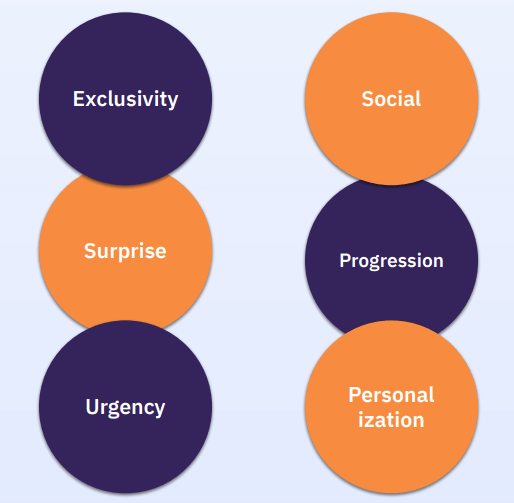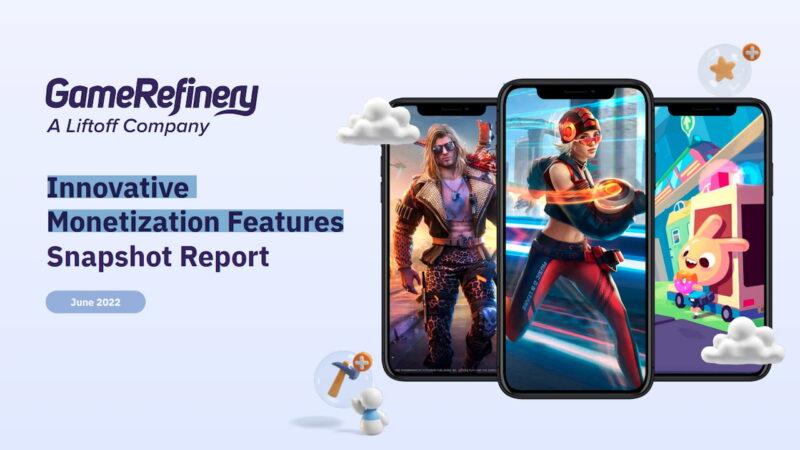Developers use many different methods to monetize mobile games. Especially for free-to-play games, choosing and diversifying the correct method is of great importance. Innovative touches to existing systems significantly affect game revenues.
GameRefinery studied game types and monetization methods. The published report discussed how the currently used battle pass (season ticket), gacha, and in-app purchase (IAP) methods are adapted to various game genres and how they affect revenues.
Battle pass, gacha, and IAP are among the most frequently used monetization methods by mobile game developers. On the other hand, players are now used to seeing and using these systems. To keep the players’ interest, the developers need to improve these methods.
The persistent power of game revenues: Battle pass
Before moving on to innovations, it is helpful to talk a little about the essence of the systems. The battle pass is a monetization method that many players and developers are familiar with. It is divided into three stages in itself and works as follows:
- Complete levels/quests
- Collect points
- Earn rewards
As you can see, the battle pass design is quite simple. The more active the players are during the time the battle pass is valid, the more rewards they get. The Battle pass system keeps the user in the game. Players want to take full advantage of the tickets they buy by paying money.
The battle pass allows players to have more content/cosmetics more economically. On the other hand, developers can keep players in the game for longer, and the money users spend to buy tickets is an important source of income.
This system directly benefits the continuous revenue generation power of games. The battle pass is seen by players as a limited-time opportunity. For developers, the situation is a little different. A new one comes after a battle pass expires, and the revenue cycle becomes continuous.
According to GameRefinery, more than half of the games today use the battle pass system. The widespread use of the system brings along innovative searches.

Battle pass benefits
The most important feature of the battle pass is that it can be used for almost every game type. It is possible to see battle pass in 4X strategy, Match-3, turn-based RPG, FPS, and many more mobile games. Regardless of their game type, the developers can easily use the battle pass, and this provides diversity within the system.
GameRefinery lists other prominent advantages of the battle pass as follows:
- Battle pass doesn’t negatively impact the gaming experience. Intrusive ads, or in-game items that must be purchased to progress, do not like by users. For this reason, battle pass significantly reduces risks such as game imbalance and player dissatisfaction compared to other monetization methods.
- Battle pass increases retention and triggers a sense of achievement. Players with the Battle pass play the game more regularly and get a sense of success with the rewards they earn.
- Battle pass positively affects game revenues indirectly as well as directly. Players who buy the ticket by paying money, provide direct income to the game. Retention increase, and the tendency of players who do not have a battle pass to spend money by emulating others also provide an indirect income increase.
Innovative battle pass examples
With the battle pass formula spread, developers began to use customized systems. Some games that offer something different to the players by going beyond the ordinary have increased their revenues significantly. Let’s briefly discuss these games and their battle pass systems.
- Auto-renew subscription battle pass
- This system, which we see in Call of Duty: Mobile, is the transformation of the battle pass, which changes with a new one every month, into a kind of membership system. With an auto-renew subscription, players do not have to repurchase tickets every month, and their battle pass memberships are renewed unless they cancel. Permanent rewards are given as an incentive to users who start a membership once, even if they cancel their membership later. This significantly increases the game’s revenues and makes the revenues more regular.
- Battle pass with piggy bank system
- This system appears in the Mech Arena as the Gold Pass. Gold Pass holders collect a kind of points during the battle pass season, accumulating them in the “Seasonal Credit Stash.” Points in the Seasonal Credit Stash, which acts as a kind of points piggy bank, give users additional premium rewards at the end of the season.
- Gifts for teammates
- With this system, which we saw in Royal Match, an automatic gift is sent to the friends of the player who buys the battle pass. This system provides a significant advantage in guild-based and social interactive games.
- Co-operative battle pass
- Top War: Battle Game uses this system. Unlike other individual battle passes, in this formula, players collect points collectively. The co-operative battle pass is the battle pass of guilds, not individuals, and each player must do their part to unlock the rewards. In addition, users who want to access all the rewards from the battle pass must also purchase tickets.
- Ad-monetized battle pass
- Solitaire Home Design uses a hybrid battle pass model. In this system, players who have purchased tickets by paying can directly access the battle pass rewards. Players who have not purchased tickets can get battle pass rewards by watching advertisements. Thus, income is also obtained from users who do not directly spend money on the game.
In summary, developers must identify the battle pass system suitable for their games. While cooperative models come to the fore in games with social features, models that indirectly bring more rewards to the user can come to the fore in individual games. In both cases, developers need to design the battle pass considering the game’s features.
Most popular monetization method of recent times: Gacha
The Gacha formula is one of the most important monetization methods that can surpass the popularity of the battle pass. The gacha system is heavily used in the USA, Japan, and China, the largest mobile game markets.

We can describe Gacha most simply as a “random reward” system. This randomness can appear in various parts of the game. My most common site is random in-game store offers that change periodically. These offers are limited-time, and if the user misses the opportunity, the probability of seeing the desired item in the store again depends entirely on luck. Various gacha systems are used in many other games, especially loot boxes.
Although the gacha system is quite profitable for developers, it is criticized by some players. In fact, some countries have restricted the use of the gacha system because of its “gambling mechanics” and addictive effect.
Innovative gacha mechanics
Gacha mechanics are customized according to the genres and objectives of the games. GameRefinery lists the innovative Gacha mechanics as follows:
- Milestone/pity gacha
- In this system, which items and at what rate will come out of a loot box is clear. The more boxes users open in a row, the better their chances of getting the item they want. To explain with an example, a weapon with a 0.25% probability of coming out of the first box you open in Call of Duty: Mobile is more likely to come out of the 20th box. The game gradually increases the chance of the desired item coming out of the box. You can see the odds in such games in the description of the items.
- Player’s choice gacha
- This system is used extensively, especially in games of Chinese origin. Players prepare their own loot box and add the items he wants to get out of it. The algorithm of the game gives these items a rate and determines the price of the box.
- Joint-pull gacha
- In this system, which we can also describe as “joint pool gacha,” players come together and share the prizes in a prize pool. Which player gets which prize is entirely random.
Gacha mechanics find an interesting response in players. Players with rarer items in Gacha feel special. Many games restrict the acquisition of gacha items without spending money, so players feel like they are getting a special reward for their money.
Indispensable monetization method for free-to-play games: In-App purchase (IAP)
IAP is a monetization method used in almost all free-to-play games. IAP is a broad topic, and the above battle pass and gacha systems are also included in the general meaning of IAP.
IAP is subdivided into subgenres, and “limited time offers” offers have reached up to 100% popularity among mobile games.

IAP is a method that has been used since the early stages of gaming history. Recently, the traditional understanding of IAP has changed a bit. In the conventional version, items such as health, energy, accelerators, and items that will affect the core gameplay are sold. New IAPs focus on longer-term goals. This new system, called progressive IAP, aims to satisfy players in the long run.
IAPs appeal to player motivations
Users play games with various motivations. Some types of IAP are designed to target these motivations in players:
- Exclusivity
- A sense of exclusivity is created if players can only access the item they want via IAP. Thus, the user thinks that what he buys cannot be found in everyone and is unique.
- Surprise
- A player who buys an item through IAP methods, such as discounts, and short-term special offers, considers a significant return on a low investment. This triggers user motivation and a sense of accomplishment.
- Urgency
- The user may believe they won’t get a second opportunity if they miss out on the offer, or, if the right offer comes at the right moment, the user may think this IAP offer is not to be missed, includes something they’ll need, and must be purchased right away.
- Social motivation
- Users playing with their friends can get costumes, items, etc., and may encourage each other to purchase such items. In addition, the fact that each player playing as a team has the same unique content increases the sense of collective satisfaction.
- Progression
- If the user can progress with the item obtained with IAP, they may want to spend money on it. For example, an accelerator that shortens the construction time in the 4X strategy game or an extra life that will allow passing the level in the Match-3 game may attract the user’s attention. In such cases, players spend money to satisfy their sense of progress.
- Personalization
- Users who can make visual/functional changes to the game character/item establish a different connection with the game. They show more loyalty to the character/city, developed by spending effort and money, and adopted it.

IAP offers must address the above motivations. Offers that meet the player’s expectations and evoke various emotions will attract more attention.
Innovative IAP offerings
Some IAP models are more successful than others. According to GameRefinery, here are the successful IAP proposals and examples:
- Mystery Shop IAP event
- This system, which we saw in Garena Free Fire, offers users up to 90% discounts for a limited time and randomly. Thus, more users spend in-game during the event period, and the game’s revenues increase significantly. This offer triggers motivations for urgency and progress in players. It is possible to see similar limited-time discount offers in many games.
- Change Your Fate IAP event
- Yet another example from Garena. During this event, users can make changes to the packages offered. Here, the refresh mechanic is used, and if the players do not like the package/discount offered, they can get another offer by renewing it.
- Limited quantity IAP offer
- In this method, which we saw in Dragon City Mobile, users are offered offers with a limited count. For example, the Lunar Shadow offer is limited to 1000 units, and the player cannot take advantage of this offer if they are late. Players need to hurry to be in the first 1000 people.
As a result, IAP offers are pretty extensive, and it is possible to see different variations in almost every game. Developers need to look further to the horizon to find the right IAP formula for them. It’s also helpful to look at what others are doing, rather than just focusing on the type of game they produce.
On the other hand, developers must determine the player motivation they want to address while designing the IAP. Each proposal appeals to a different audience and motivation. The right choices significantly increase revenues.
What will be offered to the players in the IAP offers is also very important. We’ve explained how developers can “take advantage” of IAP, but it’s entirely their choice “what” they offer their users. Choosing the right content that can appeal to the player base and combining it with IAP offers will provide a great advantage.
In conclusion
The mobile game industry is growing very fast. This growth brings competition, and developers need to be innovative to stand out from their competitors. It is important to improve traditional offers that users are now accustomed to.
Inventing a monetization method from scratch is may unnecessary to be innovative. Getting to know the game and the player and correctly determining the expectations allows you to make many customizations in traditional monetization methods.





